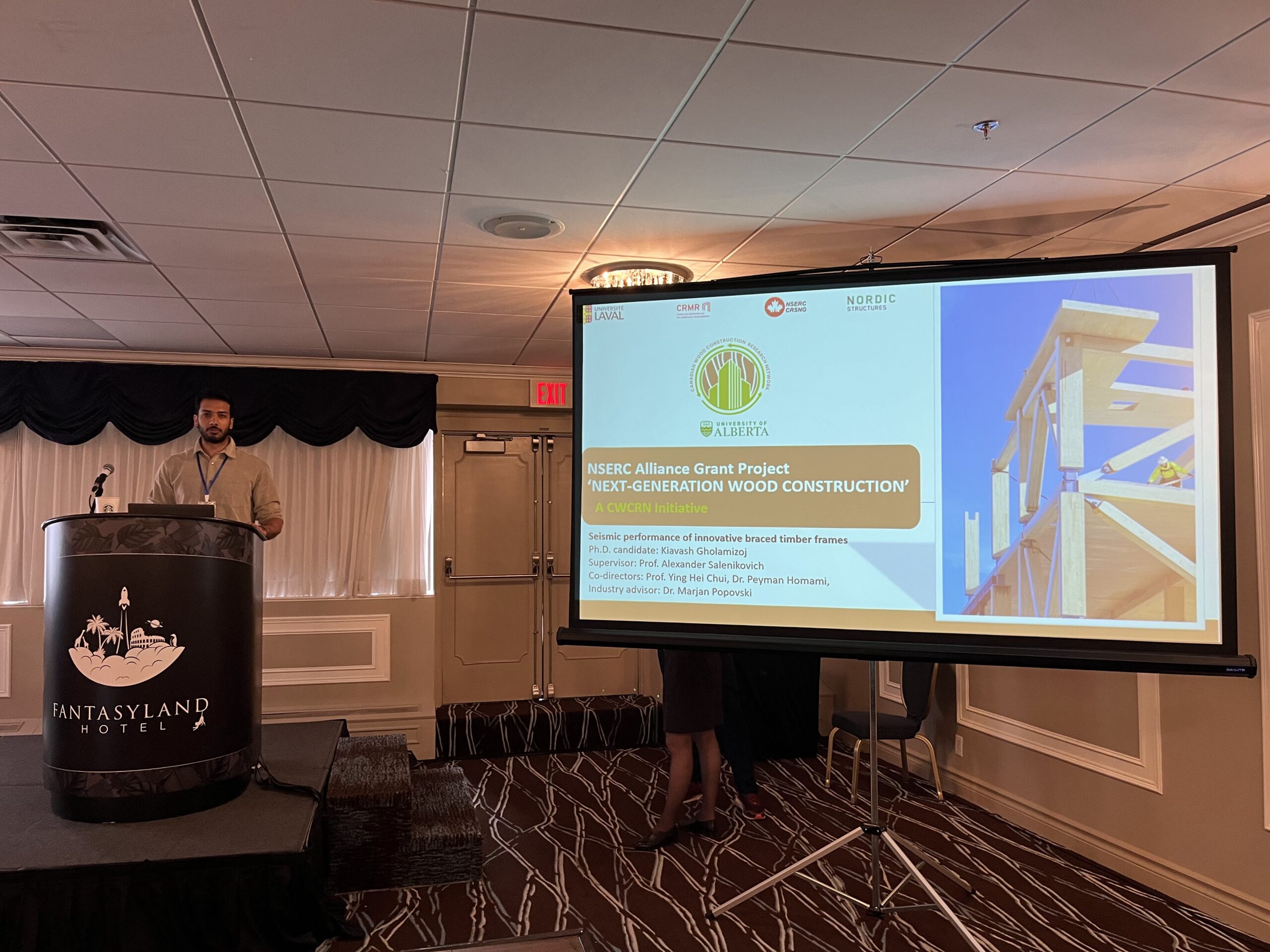Participation of Kiavash Gholamizoj at the NextGen Wood Conference 2024!
Kiavash Gholamizoj, a PhD student in wood and bio-based materials engineering under the supervision of Alexander Salenikovich, had the opportunity to attend the « NextGen Wood Conference 2024 », held on May 13-14, 2024 in Edmonton (AB, Canada). Kiavash presented his innovative research on the « Seismic performance of innovative braced timber frames ».
This opportunity allowed Kiavash to share his discoveries and scientific advances with an international audience of peers and industry professionals through an oral presentation, , thereby expanding his areas of expertise and his network of contacts.
the financial support from the CRMR’s student mobility program played a crucial role in making this enriching experience possible. Thanks to this financial aid, Kiavash was able to represent his institution and actively contribute to the advancement of research in his field.
Congratulations to Kiavash on this achievement, and we wish him every success and prosperity in his academic and professional career!

Titre of presentation: Seismic performance of innovative braced timber frames
Abstract: Conventional braced timber frame structures, when subjected to severe earthquakes, encounter challenges such as the pinching effect, degradation of strength and stiffness, and potential premature brittle failure due to seismic energy dissipation relying heavily on the connections between timber braces and main frames. To address these issues, this research aims to enhance seismic performance through innovative design solutions. A novel braced timber frame integrated with friction dampers is proposed and its seismic behavior evaluated using response spectrum analysis. Results demonstrate significant reductions in seismic demands. A critical aspect of this system is the design of robust connections. Consequently, the project focuses on designing and validating such connections through experimental testing.
Background and Objectives: Recent advancements in the timber construction industry have led to the increased use of engineered wood products in mid to high-rise structures. However, challenges persist, including insufficient moment-resisting capacity, unexpected brittle failure modes in connections, and inadequate lateral stiffness. Traditional timber braces are brittle in tension, necessitating more ductile lateral force-resisting systems (LFRS) to improve seismic performance. Friction dampers emerge as promising passive control systems for dissipating seismic energy due to their simplicity and reliability. This study introduces an innovative LFRS utilizing glued-laminated timber braces equipped with friction dampers, aiming to enhance seismic resilience in multi-story timber structures. Research Method/Approach: The research begins with a literature review of existing seismic force-resisting systems (SFRS) for multistory buildings, followed by the design and analysis of a multistory timber structure using ETABS software. Connections are then designed according to relevant standards for comparison and validation through experimental testing. Finally, a detailed numerical model incorporating experimental results is developed using Opensees software. Summary of findings to date: The proposed braced timber frame system significantly reduces seismic demands, including axial forces and base shear. Promising connection options identified include dowels with double knife plates and inclined self-tapping screws. Expected Key Output and Potential Impact of Research: This research aims to demonstrate the efficacy of the proposed LFRS for multi-story timber structures in high-seismicity areas. It is anticipated that through experimental testing, optimal connection designs will be identified, and a numerical model will be developed to facilitate further analysis and enhance the seismic performance of such structures.
Research Method/Approach: The research begins with a literature review of existing seismic force-resisting systems (SFRS) for multistory buildings, followed by the design and analysis of a multistory timber structure using ETABS software. Connections are then designed according to relevant standards for comparison and validation through experimental testing. Finally, a detailed numerical model incorporating experimental results is developed using Opensees software.
Summary of findings to date: The proposed braced timber frame system significantly reduces seismic demands, including axial forces and base shear. Promising connection options identified include dowels with double knife plates and inclined self-tapping screws.
Expected Key Output and Potential Impact of Research: This research aims to demonstrate the efficacy of the proposed LFRS for multi-story timber structures in high-seismicity areas. It is anticipated that through experimental testing, optimal connection designs will be identified, and a numerical model will be developed to facilitate further analysis and enhance the seismic performance of such structures.

